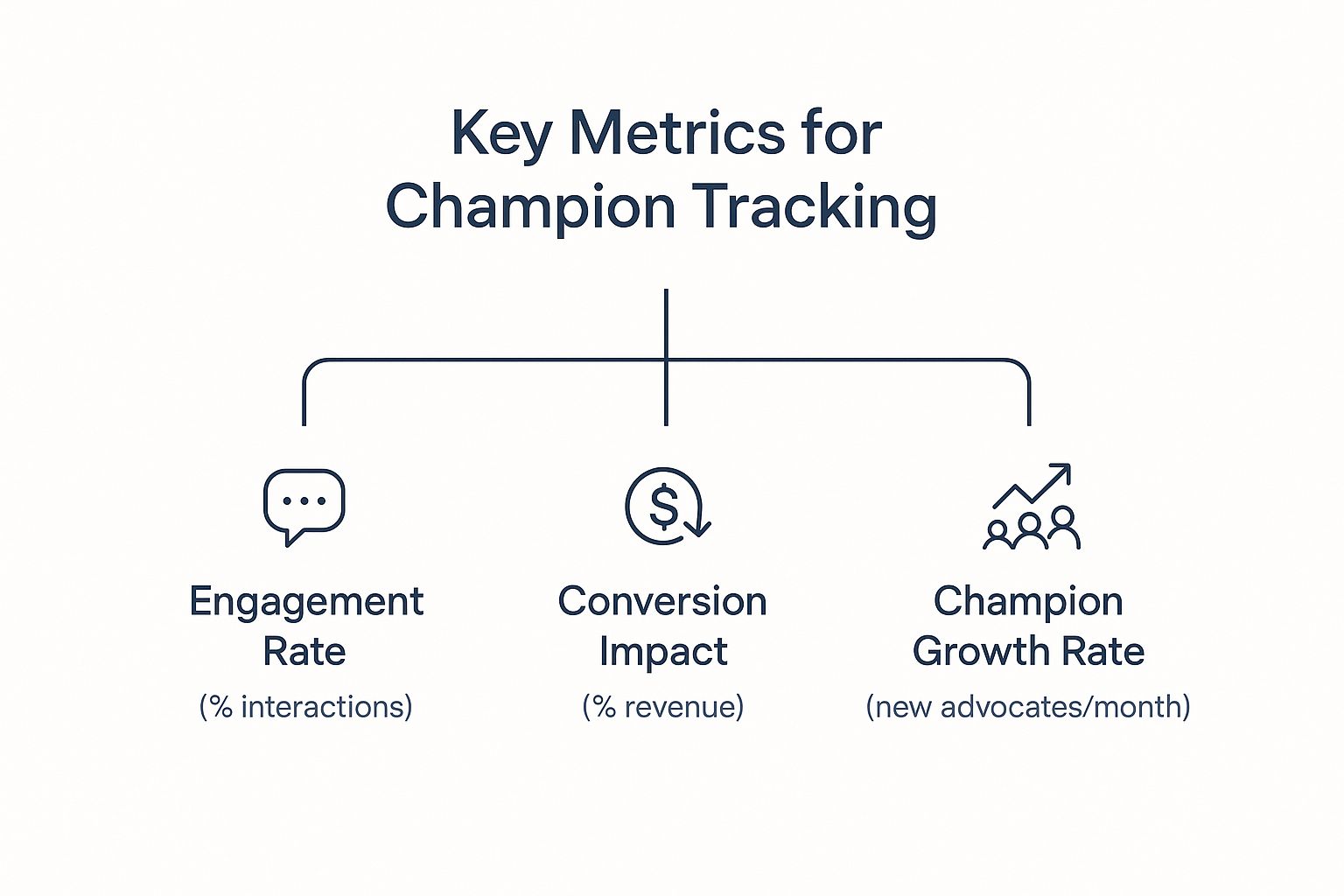How to Generate Pipeline by Tracking Your Champions
Learn how tracking your champions can help you generate more pipeline. Discover manual and automated methods, including Salesmotion, UserGems, and...
Unlock deals faster with our guide to champion tracking. Learn how to identify, enable, and track internal champions to close more B2A B sales.
TL;DR: Champion tracking is all about finding and empowering the internal advocates who sell for you when you're not in the room. By systematically tracking these key contacts, especially when they move to new companies, you tap into a powerful source of warm pipeline that leads to faster deals and higher win rates.
Let's be honest, the most complex B2B deals are almost never closed by a lone wolf salesperson. They’re won from the inside by an internal champion—that key contact who truly gets your solution and has the influence to build consensus across their company.
Champion tracking is simply the process of systematically identifying, nurturing, and keeping tabs on these critical allies to push deals across the finish line.
Think of it this way: you’re not just selling to a company; you're partnering with someone inside that company to help them solve a problem they genuinely care about. When you find this person, they become your guide, helping you navigate the messy web of internal politics and get you in front of the right decision-makers.
Without a champion, your deal is on shaky ground. Sure, you might have a friendly contact, but if they don't have the juice to get the budget approved or bring the economic buyer to the table, you're just spinning your wheels.
A true champion, on the other hand, does the heavy lifting for you. They are the ones in the internal meetings making your case. This isn't just theory; it leads to tangible results:
Modern sales teams have stopped doing this manually. They use specialized tools to automate the entire process. Platforms like UserGems and Champify really pioneered this space. Now, account intelligence platforms like Salesmotion have integrated champion tracking to ping you the second a past customer or key contact lands at one of your target accounts.
This creates a pipeline of incredibly warm opportunities that your competitors will completely miss. At the end of the day, effective champion tracking is about turning your past relationships into predictable, future revenue.
To really master champion tracking, you first need a rock-solid understanding of who a sales champion is—and just as importantly, who they aren't. Too many reps mistake a friendly contact or an internal "coach" for a true champion. It's an easy mix-up, but one that can stall deals and burn through countless hours.
A true sales champion is your internal advocate, the person who sells for you when you’re not in the room. They don’t just feed you information; they actively work to push your deal across the finish line.
Think of it this way: a coach can give you a map of the building, maybe point out a few key offices. But a champion has the master keys. They can actually unlock the doors to the executive suite and get you in front of the people who sign the checks.
It's easy to get these roles jumbled, so let’s break them down. Your champion is a world away from a simple contact because they possess three critical attributes:
This infographic gives you a visual on the key metrics you'll use to measure just how effective your champion tracking efforts are.

As the diagram shows, a champion’s value isn't just about how much they engage with you. It's measured by their direct impact on revenue and their ability to create even more internal advocates for your cause.
The concept of a champion is so vital that it's a cornerstone of powerful sales methodologies like MEDDIC, where the 'C' stands for Champion. This framework basically says that finding and testing your champion isn't a "nice to have"—it's a non-negotiable step for qualifying any serious opportunity.
Pinpointing this person means looking past surface-level friendliness. A coach might hand you the org chart, but a champion will get you that coveted meeting with the CFO. This distinction is the bedrock of effective champion tracking. It's what allows you to pour your energy into the deals that actually have a fighting chance of closing.
This idea of data-backed performance tracking is exploding everywhere. Just look at the sports analytics market—it's projected to rocket from $4.5 billion in 2024 to over $29 billion by 2034, all driven by this same obsession with tracking what truly moves the needle. You can dig into more on this rapid market expansion over on Precedence Research.
To sharpen your focus, it's crucial to understand the different players you'll encounter inside a target account. Misidentifying your champion can be a costly mistake, so let's clarify the key roles. This table breaks down the main attributes of each, helping you see where your contacts really stand.
| Attribute | The Champion | The Coach | The Detractor |
|---|---|---|---|
| Primary Motivation | Personal win; solving a pain that directly affects them or their career. | General goodwill; wants to be helpful and provide information. | Protects the status quo; sees your solution as a threat or unnecessary. |
| Level of Influence | High. Has credibility and direct access to decision-makers. | Varies. Often well-connected but lacks sway with budget holders. | Can be high or low, but actively works against your deal. |
| Actions Taken | Proactively sells for you, builds internal consensus, removes roadblocks. | Provides intel, org charts, and advice. Is reactive, not proactive. | Blocks access, raises objections, champions a competitor. |
| Risk to Your Deal | Low. Their success is tied to yours. | Moderate. Can provide misleading or incomplete information. | High. Actively tries to kill the deal. |
Think of this table as your field guide. Use it to test your contacts against these criteria. A coach is a great asset, but they won't carry the deal over the finish line. A detractor needs to be neutralized. Only a true champion has both the will and the power to make the win happen.

Spotting a true champion in a deal can feel like searching for a needle in a haystack. But it doesn't have to be a guessing game.
With the right framework, you can turn this crucial task into a repeatable science. You'll equip your reps to pinpoint those high-potential advocates early and often, looking past friendly chats to focus on the specific behaviors and language that really matter.
A great place to start is simply listening to how a contact talks. Do they consistently say "we" instead of "I" when discussing their problems? This tiny linguistic shift is often a huge tell, signaling they're thinking about the broader organization's success—a hallmark of a potential champion.
Even more telling is their willingness to take action. When a contact offers to connect you with their boss or other key players, they're not just being helpful. They're investing their own political capital in your success.
To make champion tracking more concrete, you need to arm your team with a checklist of behaviors and a handful of sharp discovery questions. These are the things that separate passive contacts from active advocates.
Look for these key behaviors:
Observing is one thing, but you also have to actively test your potential champion. You can learn more about these subtle but powerful buying signals sales reps should look for in our detailed guide.
A true champion isn’t just a fan of your product; they are personally invested in the outcome it delivers. Their success becomes tied to your success, creating a powerful internal alliance that can weather procurement hurdles and competitive threats.
The best source of truth for finding future champions is your roster of past ones. Go back and analyze your closed-won deals from the last year. It’s time to build an "Ideal Champion Profile" based on what these winners have in common.
Consider these factors:
This data-driven approach pulls the subjectivity out of the process and gives your team a clear model to work from.
This isn't just a sales tactic; it's part of a massive trend. The global player tracking system market, for instance, was valued at $7.02 billion in 2024 and is projected to hit $20.44 billion by 2030. You can discover more insights about this market growth on GrandViewResearch.
By creating a profile, you’re giving your reps a powerful filter to qualify contacts and focus their energy where it will actually move the needle.
Finding your champion is a huge step, but it’s really just the starting line. Now the real work begins. You have to turn that friendly contact into a true internal advocate, someone who can sell for you when you’re not in the room. This isn’t about asking for favors—it's about strategically arming them with everything they need to win the internal battle.
Your mission is to make their job as an advocate as easy as possible. When you get ahead of their needs and equip them properly, you build an incredible amount of trust. It shows you’re a partner, not just another vendor trying to close a deal. This is often the single biggest difference between a stalled deal and a closed-won victory.
The most powerful weapon in your champion's arsenal is a rock-solid business case they can proudly present to their boss. But don't just email them a generic template. The real magic happens when you build it with them, side-by-side, making sure it speaks directly to their company's world.
This collaborative process should look something like this:
Think about it this way: you’re making your champion the hero of the story. They're the one bringing a game-changing solution to the table. When you do that, your success becomes directly linked to their professional advancement. That’s a powerful motivator that turns simple support into true ownership.
Your champion is going to get hit with questions, pushback, and skepticism from all sides. You can't be there to jump in, but you can prepare them to handle anything that comes their way. Think of it like giving them a set of "battle cards" for their internal meetings.
This enablement package should be simple, sharp, and easy to use. Include things like:
By providing this level of support, you take the pressure off your champion. They don't have to spend hours figuring this stuff out alone. This thoughtful approach to champion tracking and enablement doesn't just strengthen your relationship; it dramatically improves your odds of winning the deal.

If you're still relying on your reps to manually update your CRM for champion tracking, you're building a strategy on outdated data. It’s a recipe for missed opportunities. Today’s sharpest sales teams have moved on, automating this entire motion with a dedicated tech stack that turns old relationships into a predictable pipeline engine.
Just look at the screenshot from Salesmotion above. It’s a perfect example of how modern platforms surface critical account signals in a clean, actionable way. Instead of reps wasting hours on manual research, they get real-time intelligence delivered right into their workflow.
The need for automated champion tracking didn't just appear out of nowhere; it created an entirely new category of sales technology. Platforms like UserGems and Champify were the pioneers here. They built tools focused on one thing and one thing only: monitoring the job changes of past customers and key contacts.
Their success proved just how valuable this one sales play really is. These tools plug directly into your CRM and keep an eye on your contacts' career moves. The moment a former champion takes a new job at one of your target accounts, the platform fires off an alert. Just like that, you have an instant warm lead.
Automating champion tracking isn't just a time-saver; it’s a strategic advantage. It ensures you’re the first to know when your biggest advocates move, giving you a crucial head start over competitors who are still cold calling.
As the market has grown, this powerful capability is no longer a standalone feature. It's now being woven into broader sales intelligence tools. For instance, a modern sales intelligence platform like Salesmotion includes champion job-change alerts as a core part of its account intelligence engine.
This integrated approach creates a much more unified and powerful workflow. Instead of just getting a simple job-change alert, sales teams get that alert alongside other critical signals from the account, such as:
This gives reps a much richer context for their outreach, helping them craft a message that is both compelling and perfectly timed. To manage all these moving parts, your team can pull from a variety of tools. For a wider look at what's out there, you might want to explore a list of the Best Sales Apps available today.
The technology driving this kind of tracking is seeing massive growth in many other sectors, too. Take the wearable fitness tracker market—a form of champion tracking for athletes—which was valued at a staggering $62.92 billion in 2024 and is projected to hit $352.03 billion by 2033.

A brilliant champion tracking strategy is just a nice idea until it’s part of your team's DNA. To get real results, you have to pull it off the slide deck and embed it directly into the daily grind, making it an undeniable part of your sales culture.
This whole process kicks off by making the concept real inside your CRM. It's not enough to just have a contact anymore; you need to know if they're actually a champion. A simple—but incredibly powerful—first move is to add a dedicated field like "Champion Status" with options like 'Identified', 'Engaged', and 'Confirmed Advocate'.
This one small tweak forces reps to qualify their contacts beyond a surface-level chat. It makes champion identification a standard, unavoidable part of every single deal review.
Once the CRM is ready, it's time to overhaul your sales playbook. This is how you get everyone speaking the same language and running the same plays. No need to overcomplicate things. Just focus on a few key updates.
The goal is to make champion tracking a reflex, not an afterthought. When it’s built into the tools and processes your team uses every day, it becomes a natural part of how they sell, driving consistency and accountability.
Finally, you have to bake champion-focused metrics into your pipeline reviews. What gets measured gets managed, right? This is where you tie your strategy directly to ROI.
Start tracking the win rate and sales cycle length for deals with a confirmed champion versus those without. The data will speak for itself. You’ll get a crystal-clear picture of the impact on your revenue.
For sales leaders looking to dial this in even further, digging into RevOps best practices can provide a rock-solid framework. You can explore some key RevOps best practices to improve your sales motion in our detailed guide.
By making these operational shifts, champion tracking stops being just another initiative. It becomes a core engine driving your team’s success.
A coach gives you information and advice about their company's internal landscape. A champion takes it a step further by actively selling on your behalf to decision-makers. A champion has a personal stake in your success and the influence to move the deal forward.
This presents two opportunities. First, use a tracking tool like UserGems, Champify, or Salesmotion to see where they land—you might have a new warm intro. Second, work quickly with your remaining contacts to identify and empower a new champion to maintain the deal's momentum.
Measure the impact by comparing key metrics on deals with a confirmed champion versus those without. The main metrics to track are win rate, sales cycle length, and average deal size. You should see a significant lift in all three areas for deals where you have a strong, engaged champion.
Stop wasting hours on manual research and start turning account intelligence into revenue. Salesmotion automatically finds the critical "why now" signals in your target accounts, empowering your team to have smarter conversations and close bigger deals, faster. Discover how Salesmotion can transform your sales process today.
Learn how tracking your champions can help you generate more pipeline. Discover manual and automated methods, including Salesmotion, UserGems, and...
Unlock your B2B sales potential. This guide reveals how to identify, engage, and persuade the economic buyer—the ultimate decision-maker.
Unlock the power of B2B intent data. Learn how it works, why it matters, and how to use it to identify buyers and close deals before your competitors...